How to measure and evaluate training effectiveness
Discover the five main models used to assess the effectiveness and success of a training program through training evaluation.

To be successful, every organization must train its staff. Training can be a minimal program focused on onboarding workers and imparting the basic knowledge required to work. Or training can be a more in-depth program to add new enriching workforce skills or develop specific employees for future roles.
Regardless of focus or scale, it is critical to evaluate training effectiveness and ensure it delivers on its intended goals. In this blog, we will cover the following:
- What is training evaluation?
- What is training effectiveness?
- The importance of measuring training effectiveness
- Models to evaluate training effectiveness
- 5 steps how to measure training effectiveness
What is training evaluation?
Appropriate training evaluation processes help organizations spot gaps in their L&D efforts and identify new learning opportunities that could produce higher-impact outcomes.
What Is training effectiveness?
Training evaluation is a very similar concept, sometimes used interchangeably with training effectiveness. Although there is a significant crossover between the two, there is a distinction to be made between training effectiveness focusing on enhancing employee processes, and training evaluation that is focused on improving training processes.
However, this means training effectiveness must measure what employees learn and how they apply it in the workplace.

Knowledge for knowledge’s sake is wasted if employees do not effectively utilize it in their work. These two concepts combine to deliver a comprehensive view of training effectiveness:
- Learning – What knowledge or skills did employees acquire during training?
- Learning Transfer – How do employees apply training material in their day-to-day work?
While you can incorporate employee assessments into training courses and ask for feedback post-session to help you understand what each employee learned; it is typically more work to determine how this knowledge is utilized in the workplace.
Measuring “learning transfer” often requires using advanced learning metrics or key performance indicators (KPIs) to track how effective an employee is at their role pre-and post-training.

Build a learning culture: a practical workbook for your organization
Upgrade your organization’s learning culture with clear, actionable strategies to address the challenges.
Download workbookThe importance of measuring training effectiveness
Every part of a business needs to justify its inclusion and show a return on investment. Training is no exception.
Therefore, evaluating training effectiveness with relevant learning metrics is critical to maintaining successful employee development.
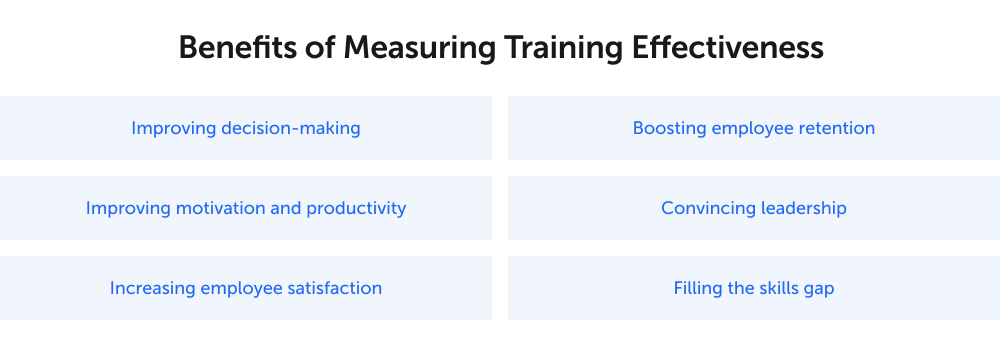
Accurately understanding the outcomes of an organization’s training efforts produces many benefits:
1. Data-driven decision making
Metrics that effectively assess training programs provide the data needed to improve decision-making. Backed up by numbers, learning metrics help organizations make smart decisions and determine the impact each choice could have.
In addition, they remove personal bias, prevent decisions made on small-sample sizes or anecdotal evidence, and validate L&D investments.
With metrics providing the data to improve decision-making, organizations can:
- Link training programs to financial performance metrics
- Assess training effectiveness over time and implement changes
- Compare L&D performance to competitors
Reports show that effective training and high-impact learning cultures produce a greater likelihood (up to 10x) of sustainable growth and profitability.
2. Productivity
Training looks to improve employees, make them better at their job, and ultimately improve motivation and productivity. A better workforce generates more value, achieving more with less.
Organizations can develop more efficient programs with better results by measuring training effectiveness and improving L&D processes.
Findings from Bersin by Deloitte show high-performance learning organizations have 37% greater employee productivity.
3. Employee satisfaction
Training also increases employee satisfaction which links back to productivity and can also:
- Increase an employee’s understanding and appreciation for their work
- Provide more autonomy and opportunities for self-leadership
- Or help staff learn to deal with workplace stress
High-impact employee development generally leads to staff members who are satisfied with their results and are able to handle more significant workloads while still delivering great work.
Research has helped demonstrate the link between successful training programs and greater employee satisfaction and engagement. Surveys show 92% of US employees believe effective training positively impacts their engagement in the workplace.
LinkedIn’s 2022 workplace learning report also found that learning opportunities were the number one driver for increasing employee engagement and creating outstanding workplace cultures.
4. Employee retention
L&D is also critical for boosting employee retention.
For example, a LinkedIn report found that 94% of employees would remain at a company longer if they invested in their development.
Retaining staff reduces the cost of recruitment and allows for the invaluable build-up of institutional knowledge, which can help operations run more smoothly.
5. Convincing leadership
Leadership sometimes incorrectly sees L&D as a cost center, only necessary to onboard staff and set compliance or safety procedures. They believe it is there to facilitate, not to enhance.
In reality, L&D can become a competitive advantage generating value across the entire organization. Convincing leadership of this fact is often the primary barrier to implementing successful training programs. 49% of L&D professionals stated that “getting managers to make learning a priority for their teams” was one of their top three challenges.
Measuring training effectiveness allows L&D staff to demonstrate their worth and point to measurable outcomes backed up by hard numbers in the form of learning metrics.
6. Growing skills gap
There has never been a better time for organizations to improve their training programs. With the shift to the digital economy, accelerated by the pandemic, a growing skills gap dramatically affects many businesses.
Research by McKinsey shows 87% of organizations expect to experience skills gaps in the coming years, with 43% saying they already have one. In addition, organizations are struggling to cover the lack of relevant digital skills through hiring. The US Chamber of Commerce Foundation found that 74% of hiring managers have a shortage of skilled candidates.
Organizations with effective training programs powered by learning metrics can navigate the looming skills gaps by developing the capabilities they need in-house.

How to conduct a skills gap analysis and what to do next
Start building your foundation for strategic workforce development.
Download guideModels to evaluate training effectiveness
Organizations looking to evaluate training effectiveness have multiple models to choose from.
Below is a list of well-known models and short descriptions highlighting key takeaways. In practice, businesses can often utilize more than one model or modify their chosen model to reflect their specific needs better.
1. Kirkpatrick Model
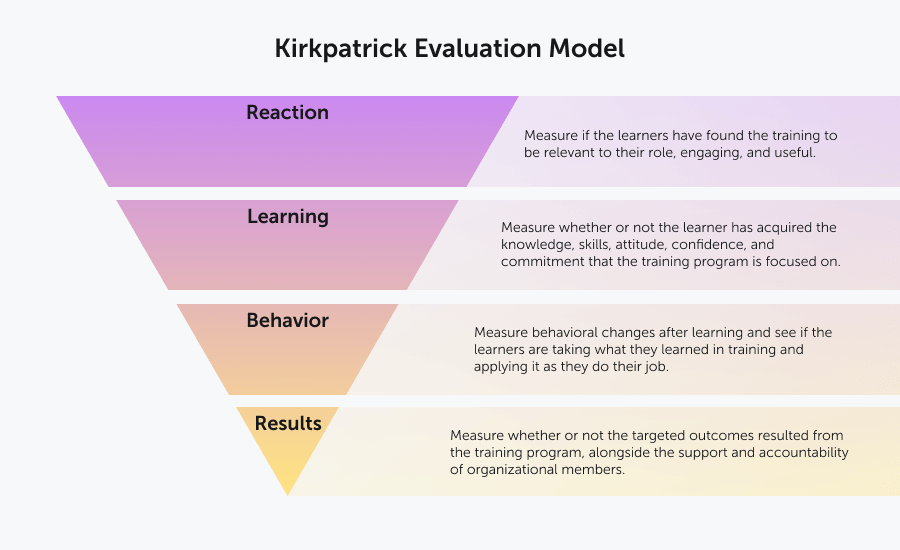
The Kirkpatrick model is the most widely used tool for evaluating training effectiveness and often the first tool organizations investigate. Developed in the 1950s, the Kirkpatrick model consists of four levels:
- Reaction – Gauge employees’ reactions or responses to the training. This feedback is generally captured through surveys, questionnaires, or interviews.
- Learning – Measure the knowledge or skills acquired by employees during the training, which could include test scores or changes to employee performance metrics.
- Behavior – How the training affects employees’ working methods (are they applying their newly gained knowledge?), behaviors, and attitudes? This could be discovered through self-assessed feedback, supervisor reports, or employee performance metrics.
- Results – Tracking the tangible outcomes of the training. This could be reduced costs, improved quality of work, greater productivity, or employee retention.
2. The Phillips ROI Methodology
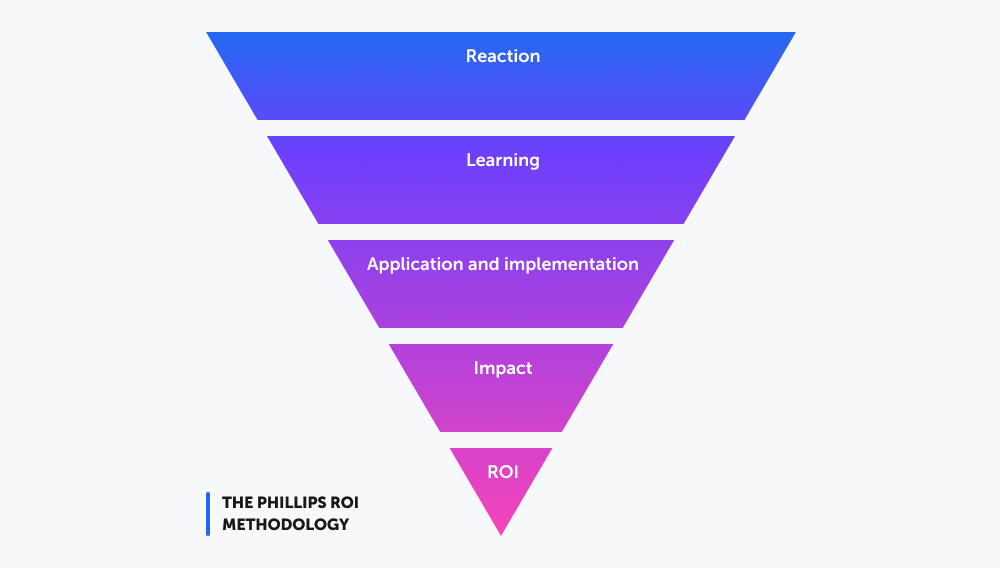
Established in 1980, the Phillips ROI methodology looks to expand on the Kirkpatrick model. It loosely follows the four stages of the Kirkpatrick model with some essential alterations and an additional fifth step.
- Reaction – Same as Kirkpatrick.
- Learning – Same as Kirkpatrick.
- Application and implementation – Rather than focusing on behavior, Phillips expands to cover application and implementation to understand how training translates to the workplace. If issues occur, are they the fault of incorrect applications (initial training) or implementations (on-the-job training)?
- Impact – Phillips looks better to isolate the effect of training from other factors.
- ROI – While Kirkpatrick measures training results against Return on Expectations (ROE), Phillips applies cost-benefit analysis to determine if L&D investments generate value.
3. Learning-transfer Evaluation Model (LTEM)
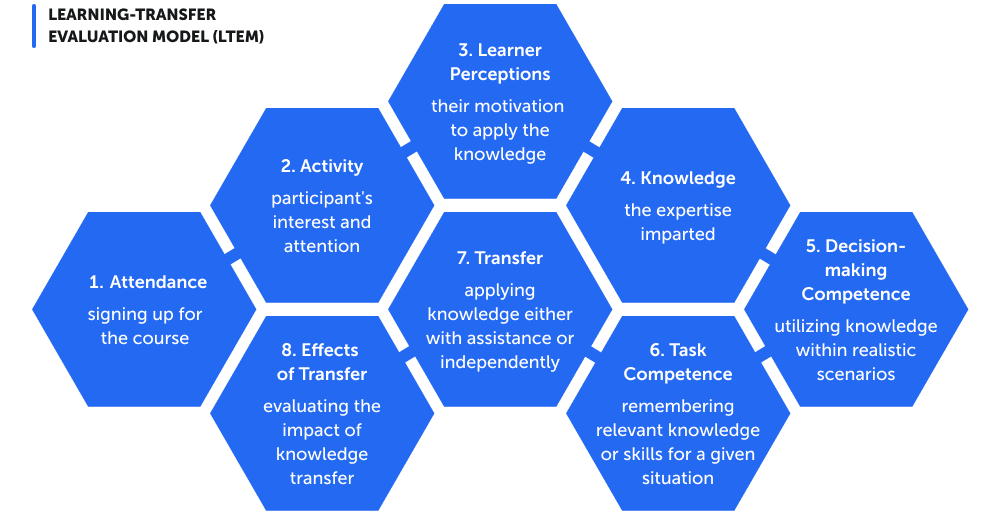
A multi-tiered method for evaluating training effectiveness, LTEM combines learning with the transfer of new skills into workplace processes. It consists of eight levels:
- Attendance – Signing up for the course
- Activity – Participant’s interest and attention
- Learner Perceptions – their motivation to apply the knowledge
- Knowledge – the expertise imparted
- Decision-making Competence – utilizing knowledge within realistic scenarios
- Task Competence – remembering relevant knowledge or skills for a given situation
- Transfer – applying knowledge either with assistance or independently
- Effects of Transfer – evaluating the impact of knowledge transfer
LTEM examines multiple factors that make up the whole learning experience.
4. Success Case Method (SCM)
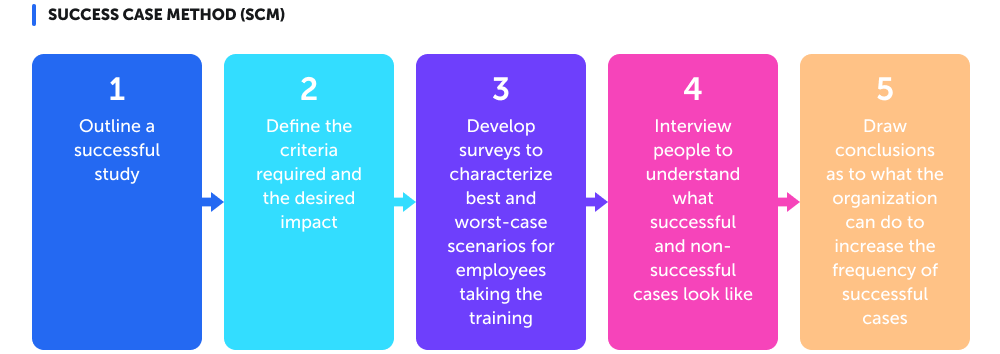
SCM utilizes surveys to assess the successes and shortcomings of a training program. What factors allowed participants to succeed, and where did employees fall through the cracks, failing to acquire or apply new information? SCM can be applied to individual training modules or the program as a whole.
It consists of five steps:
- Outline a successful study
- Define the criteria required and the desired impact
- Develop surveys to characterize best and worst-case scenarios for employees taking the training
- Interview people to understand what successful and non-successful cases look like
- Conclude as to what the organization can do to increase the frequency of successful cases
The method aims to understand why a training program works or doesn’t based on feedback from a variety of people. It can help identify existing barriers to success and methods to improve moving forward.
5. Context, Input, Process and Product Evaluation Model (CIPP)
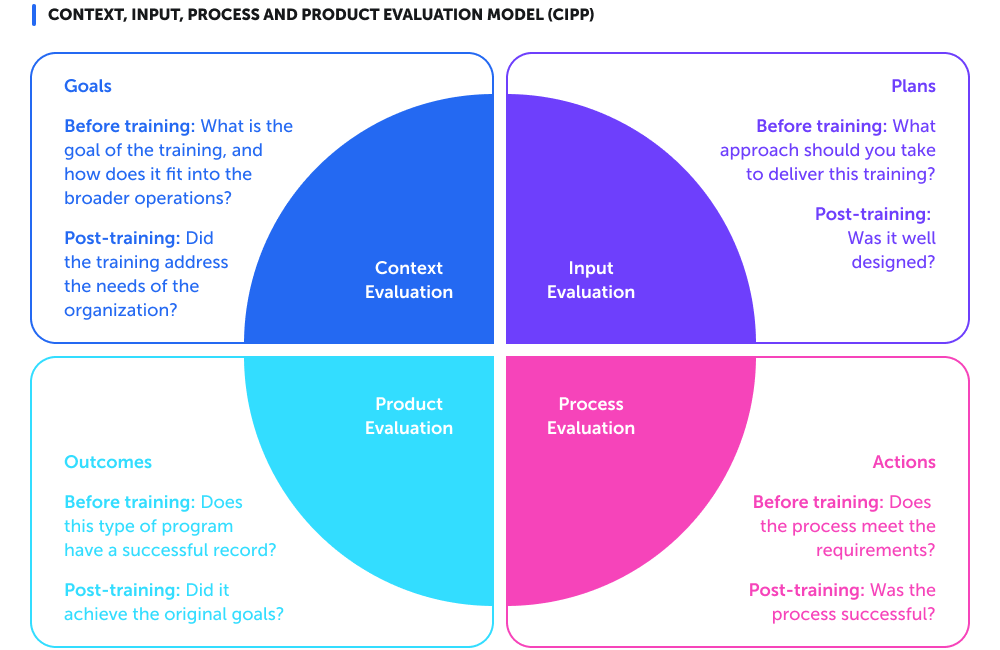
Developed in the 1960s, CIPP contains four iterative areas and can be applied both before and after training. CIPP aims to link evaluation with decision-making and provide a basis for analysis while managing L&D processes.
Before training, it takes the form of:
- Context – What is the goal of the training, and how does it fit into the broader operations?
- Input – What approach should you take to deliver this training?
- Process – Does the process meet the requirements?
- Product – Does this type of program have a successful record?
Post-training takes the form of:
- Context – Did the training address the needs of the organization?
- Input – Was it well designed?
- Process – Was the process successful?
- Product – Did it achieve the original goals?

Build a learning culture: a practical workbook for your organization
Upgrade your organization’s learning culture with clear, actionable strategies to address the challenges.
Download workbookHow to measure training effectiveness
Measuring training effectiveness is a vital function of every L&D team.
It ensures training programs deliver valuable skills that enhance business operations and improve employee and management’s workplace experience. It also helps identify training gaps that could be improved moving forward.
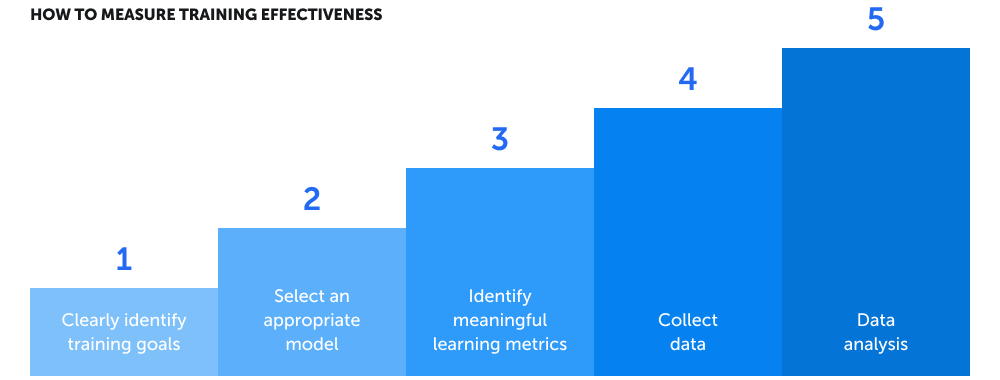
Below are five steps to help you accurately assess the effectiveness of your training programs.
1. Clearly identify training goals
Training goals create purpose and targets for L&D initiatives as well as define the criteria by which to measure training effectiveness.
Examples could include:
- Efficiently onboarding staff
- Ensuring safe operations
- Identifying and nurturing internal candidates with leadership potential
- Increasing productivity and effectively utilizing existing resources
- Closing any digital skills gaps and prepping staff for new technology integrations
- Increasing revenue and expanding operations
Whatever your specific goal is, defining it early helps develop the specific learning metrics required to assess how effective a particular training program is. Training goals should be linked to broader business values and objectives.

How to conduct a skills gap analysis and what to do next
Start building your foundation for strategic workforce development.
Download guide2. Select an appropriate model
As described above, there are multiple models to help evaluate training effectiveness, each with a different approach.
Utilizing one of these models offers a framework and methodology by which to assess training effectiveness.
Organizations should research the various models available and select the most appropriate for their operations.
3. Identify meaningful learning metrics
Learning metrics can take several forms in order to measure both “learning” (what was learned) and “learning transfer” (how it was applied). Regardless of which model you utilize, you will need to develop meaningful learning metrics that reflect training effectiveness.
Some learning metrics are relatively easy to define (e.g., course completion rate, pass rate, training cost per employee, revenue increase, etc.), while others are more nuanced. These tend to be related to behavioral changes or linking improvements (which could result from many factors) directly to training programs.
To assess behavioral changes post-training, you need a baseline for comparison. This requires tracking KPIs throughout the employee lifecycle and measuring the impact of specific training programs.
Learn more about learning metrics in our blog “10 Valuable Training Metrics to Know”
4. Collecting data
The accuracy of your learning metrics and how well they reflect the actual effectiveness of a training program are determined by the quality of the data you collect. There are many methods you can utilize to collect training effectiveness data, including:
- Training evaluation forms completed by learners after a particular session or at the end of an entire course.
- Employee interviews to get a better understanding of the learning experience.
- Focus groups made up of a small number of participants to generate more detailed information about a training program without having to interview employees individually.
- Observing employees post-training to determine any behavioral changes.
- Digital tools integrated into your learning management system (LMS) or learning experience system (LXP) to track training feedback throughout the process, giving employees more opportunities to quickly offer their opinion.
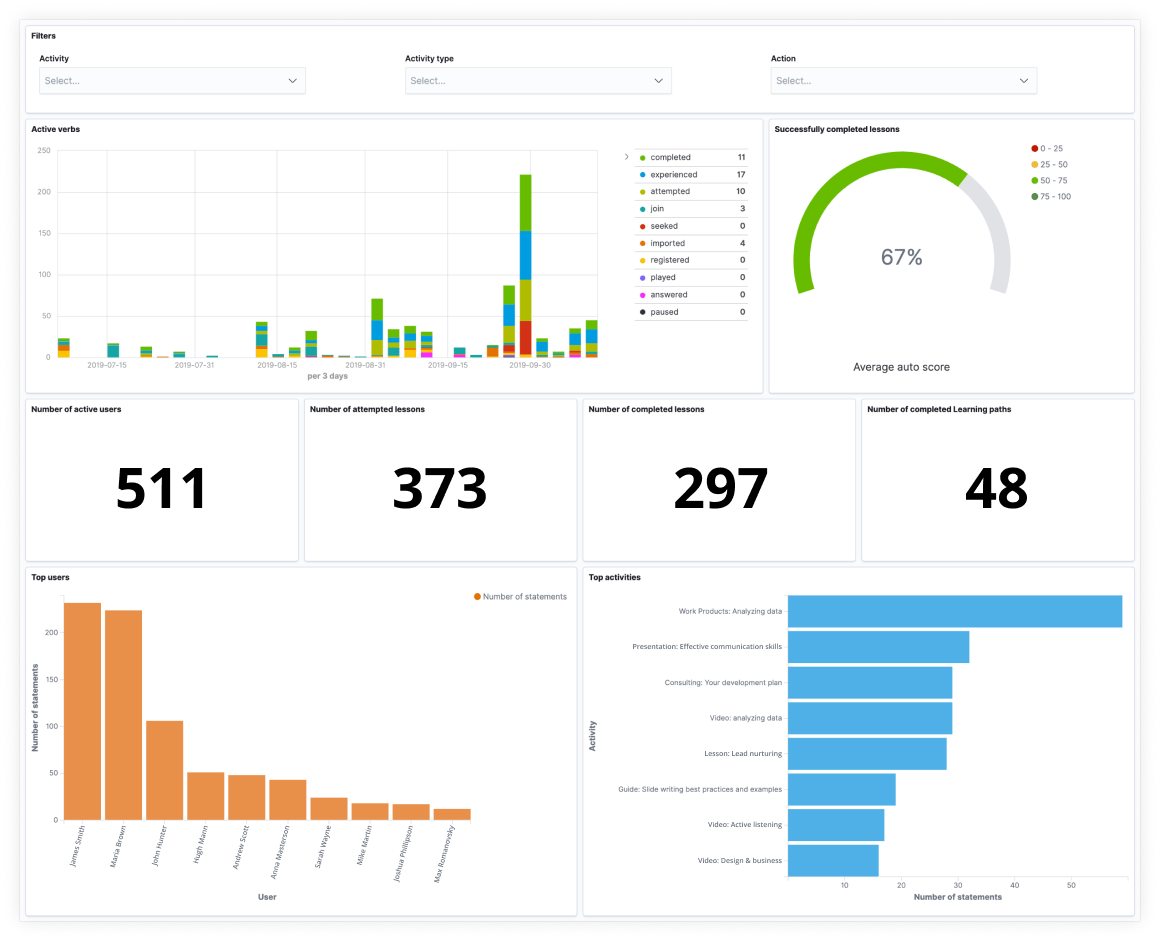
Example of Valamis learning platform and how the data is collected. With the analytics feature, you can get insights into how learning activities affect employees’ performance and as a result your business outcomes.
To build a clear picture of your training programs and their effectiveness, you will likely need to combine multiple sources of data at various stages.
Keep in mind that collecting participant feedback takes additional time out of each employee’s day, and there may be diminishing returns if you try collecting extensive amounts of data.
5. Data analysis
The final step is to analyze all the data collected and draw conclusions about its impact on the participants. This record lets you know what employees learned and how they apply this new information in their work. It also acts as a benchmark to compare to future training programs, develop new ideas, and improve existing skill gaps.
A common issue when analyzing data and deriving information on training effectiveness is finding a way to prove that performance increases are the result of the training.
Take, for example, an increase in revenue occurring after a new training program is completed. To assign credit to the training course and the new skills it generated, you need to determine a direct link between the two – causation, not just correlation.
However, with many factors combined to produce an organization’s overall performance, this is not always a simple task.
You need to track employee feedback post-training, through to the resulting behavioral changes, and how that relates to a surge in revenue. For example, did the training directly improve the product, how it was marketed, or the employees’ sales skills?
Measure the impact of your learning with Valamis
Training effectiveness and how L&D translates to employee performance can be complex concepts to nail down. However, Valamis is here to help.
With a single platform, you can measure, analyze, predict, and improve the effectiveness of your L&D programs and build a direct connection between learning activities and employee performance.




